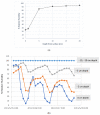'Follow the Water': Microbial Water Acquisition in Desert Soils
- PMID: 37512843
- PMCID: PMC10386458
- DOI: 10.3390/microorganisms11071670
'Follow the Water': Microbial Water Acquisition in Desert Soils
Abstract
Water availability is the dominant driver of microbial community structure and function in desert soils. However, these habitats typically only receive very infrequent large-scale water inputs (e.g., from precipitation and/or run-off). In light of recent studies, the paradigm that desert soil microorganisms are largely dormant under xeric conditions is questionable. Gene expression profiling of microbial communities in desert soils suggests that many microbial taxa retain some metabolic functionality, even under severely xeric conditions. It, therefore, follows that other, less obvious sources of water may sustain the microbial cellular and community functionality in desert soil niches. Such sources include a range of precipitation and condensation processes, including rainfall, snow, dew, fog, and nocturnal distillation, all of which may vary quantitatively depending on the location and geomorphological characteristics of the desert ecosystem. Other more obscure sources of bioavailable water may include groundwater-derived water vapour, hydrated minerals, and metabolic hydro-genesis. Here, we explore the possible sources of bioavailable water in the context of microbial survival and function in xeric desert soils. With global climate change projected to have profound effects on both hot and cold deserts, we also explore the potential impacts of climate-induced changes in water availability on soil microbiomes in these extreme environments.
Keywords: anhydrobiosis; desert soils; desiccation; hyper-arid; microbiomes; moisture stress; water activity; water availability; xerophily.
Conflict of interest statement
The authors declare no conflict of interest.
Figures



References
-
- Daniel R.M., Finney J.L., Stoneham M. The molecular basis of life: Is life possible without water? Philosoph. Trans. R. Soc. Lond. B Biol. Sci. 2004;359:1141–1328.
-
- Williford K.H., Farley K.A., Stack K.M., Allwood A.C., Beaty D., Beegle L.W., Bhartia R., Brown A.J., de la Torre Juarez M., Hamran S.E., et al. From Habitability to Life on Mars. Elsevier Publisher; Amsterdam, The Netherlands: 2018. The NASA Mars 2020 Rover Mission and the Search for Extraterrestrial Life; pp. 275–308. Chapter 11.
-
- Rummel J.D., Beaty D.W., Jones M.A., Bakermans C., Barlow N.G., Boston P.J., Chevrier V.F., Clark B.C., De Vera J.-P.P., Gough R., et al. A new analysis of Mars “Special Regions”: Findings of the Second MEPAG Special Regions Science Analysis Group (SR-SAG2) Astrobiology. 2014;14:887–968. doi: 10.1089/ast.2014.1227. - DOI - PubMed
Publication types
Grants and funding
LinkOut - more resources
Full Text Sources

